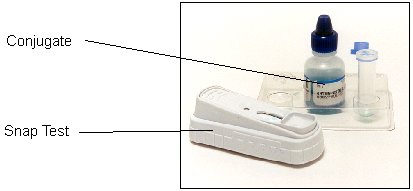
Description:
This ELISA test identifies the parvovirus in an infected dog. The test is run using a very small fecal (stool) sample taken from the suspect animal. The parvo virus is shed in great quantities in the feces of infected animals. See page F108 for additional information on parvo.Diagnostic Value:
High, but specific for parvo. In most cases this test can directly identify an animal infected with parvo.Risks to Patient: Virtually none, provided the sample is collected by a trained professional.
Relative Cost: Low to Moderate.
Test Procedure: A swab is carefully inserted into the rectum of the animal and a small fecal sample is collected. The fecal material is then combined with a pre-measured amount of buffer solution. Four drops of this mixture is then added to four drops of the provided conjugate. This mixture is rotated and the sample is placed on the snap test. The test is placed on a flat surface and the results are read in 8 minutes.
Interpretation of Results: The test has three colored dots that may appear after the test has been performed. Depending on the dots that appear, different results may be interpreted. If only the top dot appears, the test is negative and the dog probably does not have parvo. (In occasional cases a positive animal may test negative. This occurs because there is a small "window" in the infection process where no parvovirus is shed in the feces. If the test is performed during this "window," an infected animal may actually test negative.) If the dot on the right side appears, the test is positive and the dog is infected. If the dot on the left side appears, the test may need to be repeated.
Treatment: Any positive animal should receive prompt veterinary medical attention. This may involve IV fluids, blood work, antibiotics, and hospitalization. See page F108 for additional information.
